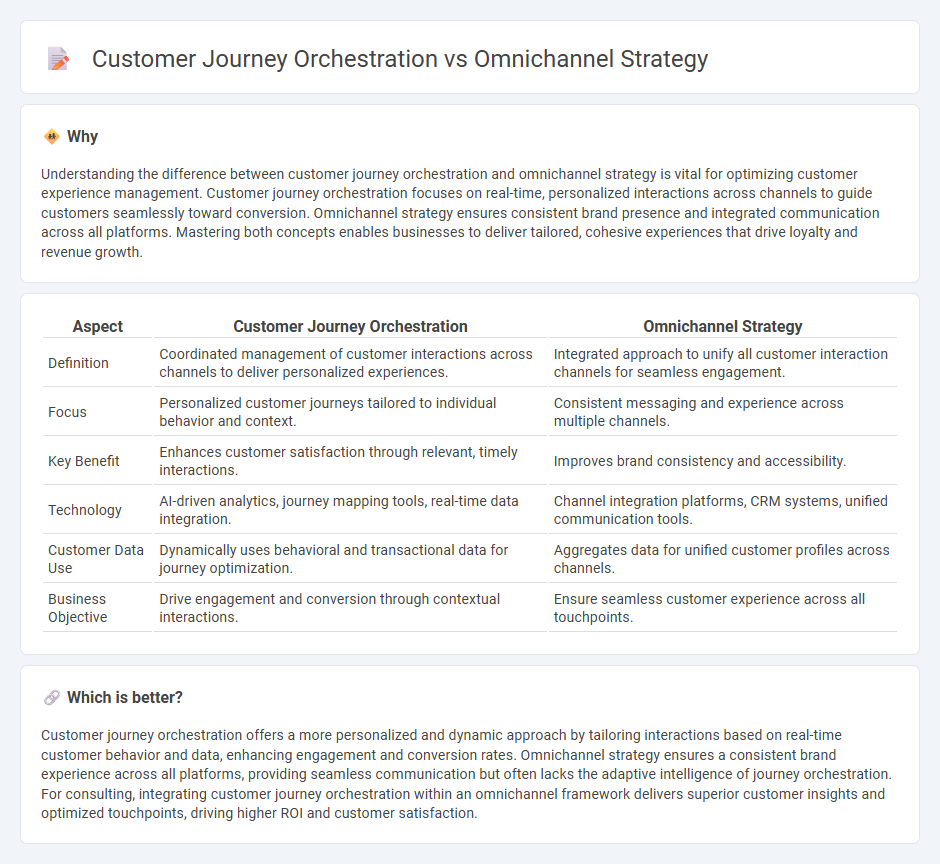
Customer journey orchestration integrates data from multiple touchpoints to create personalized and seamless experiences tailored to individual behaviors and preferences. Omnichannel strategy focuses on maintaining consistent brand messaging and service quality across all communication channels, ensuring uniform customer interaction. Explore how combining these approaches can elevate your consulting solutions for enhanced customer engagement.
Why it is important
Understanding the difference between customer journey orchestration and omnichannel strategy is vital for optimizing customer experience management. Customer journey orchestration focuses on real-time, personalized interactions across channels to guide customers seamlessly toward conversion. Omnichannel strategy ensures consistent brand presence and integrated communication across all platforms. Mastering both concepts enables businesses to deliver tailored, cohesive experiences that drive loyalty and revenue growth.
Comparison Table
| Aspect | Customer Journey Orchestration | Omnichannel Strategy |
|---|---|---|
| Definition | Coordinated management of customer interactions across channels to deliver personalized experiences. | Integrated approach to unify all customer interaction channels for seamless engagement. |
| Focus | Personalized customer journeys tailored to individual behavior and context. | Consistent messaging and experience across multiple channels. |
| Key Benefit | Enhances customer satisfaction through relevant, timely interactions. | Improves brand consistency and accessibility. |
| Technology | AI-driven analytics, journey mapping tools, real-time data integration. | Channel integration platforms, CRM systems, unified communication tools. |
| Customer Data Use | Dynamically uses behavioral and transactional data for journey optimization. | Aggregates data for unified customer profiles across channels. |
| Business Objective | Drive engagement and conversion through contextual interactions. | Ensure seamless customer experience across all touchpoints. |
Which is better?
Customer journey orchestration offers a more personalized and dynamic approach by tailoring interactions based on real-time customer behavior and data, enhancing engagement and conversion rates. Omnichannel strategy ensures a consistent brand experience across all platforms, providing seamless communication but often lacks the adaptive intelligence of journey orchestration. For consulting, integrating customer journey orchestration within an omnichannel framework delivers superior customer insights and optimized touchpoints, driving higher ROI and customer satisfaction.
Connection
Customer journey orchestration integrates data from multiple touchpoints to deliver personalized experiences, enhancing an omnichannel strategy's effectiveness. An omnichannel approach ensures seamless interaction across platforms, while journey orchestration aligns content and timing based on customer behavior. Together, they drive engagement, boost retention, and maximize client lifetime value in consulting projects.
Key Terms
Channel Integration
Omnichannel strategy emphasizes seamless channel integration to create a unified customer experience across physical stores, websites, mobile apps, and social media platforms. Customer journey orchestration goes beyond channel integration by dynamically personalizing interactions based on individual behaviors and real-time data throughout the entire buying process. Explore more to understand how these approaches drive customer engagement and business growth.
Touchpoint Mapping
Omnichannel strategy integrates multiple communication channels to provide a seamless customer experience, while customer journey orchestration focuses on real-time coordination of interactions across these channels to optimize engagement. Touchpoint mapping is essential in both, identifying critical moments where customers interact with a brand, enabling personalized, consistent messaging. Explore how precise touchpoint mapping enhances both strategies for improved customer satisfaction and loyalty.
Personalization
Omnichannel strategy integrates multiple communication channels to create a seamless customer experience, while customer journey orchestration focuses on delivering personalized interactions by mapping and managing each customer touchpoint in real-time. Personalization in omnichannel strategies relies on consistent messaging across platforms, whereas journey orchestration dynamically adapts content and timing based on individual behavior and preferences. Explore how combining these approaches enhances personalized customer engagement and drives conversion rates.
Source and External Links
What is Omnichannel Marketing? Definition & Strategy - Amazon Ads - Omnichannel strategy focuses on a customer-centric approach integrating all channels to deliver a unified and consistent brand experience across both online and physical storefronts, built through steps like collecting insights, segmenting customers, and optimizing logistics for seamless experiences.
Learn about omnichannel marketing and how to develop a strategy - An effective omnichannel strategy creates a seamless, consistent customer journey by integrating online and offline touchpoints, supported by data collection, journey mapping, audience segmentation, consistent messaging, automation tools, and continual optimization for long-term results.
What is Omnichannel Marketing? Definition, Tips, and Examples - Omnichannel marketing ensures seamless, integrated branding and messaging across all online and offline channels, improving user experience, strengthening brand identity, increasing customer loyalty, and driving higher revenue by engaging customers through multiple touchpoints.
 dowidth.com
dowidth.com